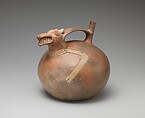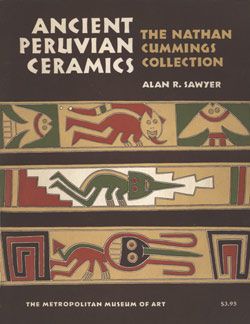Spout-and-bridge bottle with fox
For several centuries around the time of the beginning of the Common Era, artists of the Paracas people on Peru’s South Coast developed a striking style of ceramics featuring a colorful palette achieved with post-fire paints (see, for example, MMA 1979.206.1148). Around 200 BCE, however, potters from the northern part of the Ica region distinguished themselves from their Paracas counterparts by crafting elegant, highly burnished, monochromatic bottles in a style known as Topará. Red or cream slips—liquid suspensions of clay and pigments—were used to cover the entire vessel, and the smooth surfaces were carefully burnished to produce a uniform shine.
Many Topará vessels were shaped like gourds (see, for example, MMA 63.232.55), others like animals. This fox bottle was created by attaching a modeled canine head to the globular body. The frontal limbs were delineated by incisions in soft clay and later painted with a cream slip. The simplicity of the rendering contrasts with the dramatic expression of the animal. A spout in the back is connected to the head with a bridge handle. This vessel type, known as a spout-and-bridge bottle, was the South Coast’s signature shape for the following millennium.
Topará-style bottles were found in cemeteries, such as those excavated on the Paracas Peninsula at the beginning of the twentieth century by the Peruvian archaeologist Julio C. Tello. Tello dubbed the abandoned houses converted into communal graves "Necropolis," and that name has become attached to the style of ceramics, textiles, and other objects that accompanied the hundreds of funerary bundles found there. Multiple styles of ceramics—Paracas, Topará, and early Nasca—have been found together in a single tomb by archaeologists, suggesting that multiple communities of producers, each with their own techniques, palette, and image repertoire, did not only exist simultaneously but also provided wares for the same families.
Hugo C. Ikehara-Tsukayama, Senior Research Associate, Arts of the Ancient Americas, 2024
References and Further Reading
DeLeonardis, Lisa. “Interpreting the Paracas Body and its value in Ancient Peru.” In The Construction of Value in the Ancient World, edited by John K. Papadopoulos and Gary Urton, pp. 197-217. Los Angeles: Cotsen Institute of Archaeology, University of California, Los Angeles, 2012.
Lapiner, Alan C. Pre-Columbian Art of South America. New York: H. N. Abrams, 1976, p. 106.
Peters, Anne. Funerary Regalia and Institutions of Leadership in Paracas and Topara. Chungara, Revista de Antropolgia Chilena, 32, no 2 (2000), 245-252.
Proulx, Donald A. “Paracas and Nasca: Regional Cultures on the South Coast of Peru” in Handbook of South American Archaeology, edited by Helaine Silverman and William Isbell, 563-584. Springer Press, 2008.
Sawyer, Alan Reed. Ancient Peruvian Ceramics: The Nathan Cummings Collection. New York: The Metropolitan Museum of Art, 1966.
Silverman, Helaine. “The Paracas Problem: Archaeological Perspectives” in Paracas Art and Architecture: Object and Context in South Coastal Peru, edited by Anne Paul, pp. 348-415. Iowa City: University of Iowa Press, 1991.
Wallace, Dwight T. “The Topará Tradition: An Overview.” in Perspectives on Andean Prehistory and Protohistory, eds. Daniel H. Sandweiss and D. Peter Kvietok, Ithica: Cornell University Latin American Studies Program. 1986. pp. 35-48.
This image cannot be enlarged, viewed at full screen, or downloaded.


